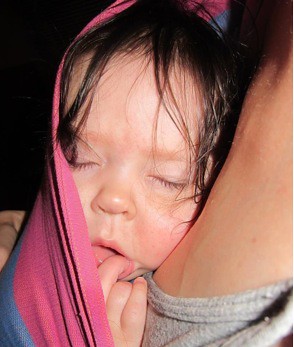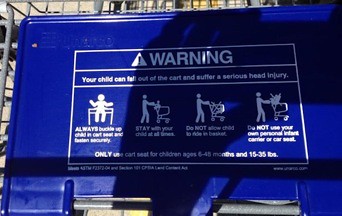Babywearing: Benefits and a Brief History

While many believe that the current babywearing trend is a recent fad, it is actually a practice that has been around for thousands of years. Anthropologists claim that babywearing, in some shape or form, has been around as long as humans have. In the beginning, it was done with whatever was available; bark, reeds, animal hides, etc. It was a way for parents to work or travel while still having their child safe and close. Because of this basis in the very early history of humankind, various types of babywearing can be found in nearly every culture and civilization. Each culture seems to have adapted it somewhat differently, which has given us much variation in our options of carriers and types of babywearing. While babywearing underwent a distinct decline in American culture during the early 1900’s in favor of strollers and a more distanced parenting style, it has experienced a gradual revival over the last 50 years due to its many benefits.
Benefits of Babywearing:
Convenience
Babywearing has endured despite the popularity of strollers and portable carseats in large part due to its convenience. Babywearing allows the parent or wearer to keep their child safe and close, while still being hands-free. This is helpful not only during the early days of infancy, when babies crave closeness and the sound of their parent’s heartbeat, but also into the toddler years, when in an area that is unsafe for quick little feet to roam or for cuddling comfort when the child is sick. Babywearing allows new moms to more easily transition back into everyday life, whether that means a new mom being able to do whatever she wants to do around the house or being able to chase after her other children, all the while keeping her young baby close. With babywearing, trips out of the house become much easier without a carseat to lug around, a stroller to fuss with and with an added benefit of means to easily breastfeed, if the mom chooses. It is impossible to name all of ways in which babywearing is convenient.
Aids in transition from womb to world
After spending 9 months in the womb, babies desire warmth, closeness, hearing a reassuring heartbeat, and the familiar smell of mom and dad. Babywearing, especially in a wrap or ring sling, simulates the feeling of the womb, which is reassuring to an infant. Many refer to the first 3 months following birth as the “4th Trimester”, during which babies respond best to stimuli similar to what they have experienced up to that point, such as familiar voices, continuous rocking movement, and the feeling of warmth and snuggness. All of these things are easily provided through babywearing. With babywearing, a newborn is able to gradually experience and absorb their new surroundings, while still having the reassurance of all that they have known prior to entering this new, chaotic world.
Healthy for moms and dads
It has become popular use infant car seats for carrying babies outside of the car. The problem with this is that it puts strain on the back and hips of the person carrying the seat. Following birth, moms still retain an excess of relaxin in their bodies for some time. This hormone relaxes the ligaments, which is great for childbirth, but not for heavy lifting. When lugging around an infant seat, a mom is not only carrying additional weight because of the seat, but she is often doing it at an awkward manner, with the weight unequally distributed. While this is worse for a new mom with high relaxin levels remaining in her system, it is not ideal for anyone to do on a regular basis since it puts such such a lopsided strain on the spine. Babywearing, on the other hand, when done properly, evenly distributes the newborn’s weight and alleviates the excess weight of carrying a car seat or stroller.
Safe environment
With the aforementioned popularity of the portable infant car seat, has come the the practice of placing the car seat on the top of shopping carts. Unfortunately, the clip that keeps the car seat secure in its base inside the car was not designed to secure the seat atop a shopping cart. Because of this fact, there have been numerous cases of infants being injured when when their seat toppled off of the cart and tragically even a few deaths as a result. Large shopping chains have begun to place warnings on their carts to discourage parents from placing car seats on top of the carts, urging them to instead place the seat inside the basket of the cart. Babywearing offers yet another safe alternative. Some added benefits to this option are the additional space in the cart basket when the car seat is left in the car and the close proximity allowing the baby to be easily soothed should the need arise.

Easier breastfeeding
The benefits of babywearing to the breastfeeding relationship are numerous. Many babywearing moms find it easier to nurse their babies more frequently, which aids in infant weight gain. If a mom feels uncomfortable, babywearing can add some privacy to nursing in public. It is much easier to notice a baby’s hunger cues when they are already so close to the breast. Because of this, a mom can easily place her baby to the breast before her baby cries in hunger, thereby drawing even less attention to the fact that the baby is even nursing. The coverage offered by babywearing while nursing not only offers privacy for a mom who desires it, but often helps to keep the nursing baby from becoming distracted. Moms who are experienced at nursing while babywearing are often able to do it hands-free, which is definitely an added convenience considering how frequently new babies need to nurse.

Aids in babies’ cognitive development
When babies are worn as opposed to being carried in infant seats or pushed in strollers, they see the world at their parent’s level. When they are up at their parent’s height, they are able to watch them interact through verbal language, facial expression and body language. Studies also show that babies cry less when worn, which allows them to calmly take in their surroundings. They are reassured by the constant closeness of their parent and are able to comfort themselves by turning into the safety of the parent if the surrounding stimuli overwhelms them. While being worn, a baby experiences constant varied movement, which also aids cognitive development, specifically in the areas of the brain associated with balance. The constant varied movement helps build pathways associated with balance, but also helps develop the part of the brain associated with core muscle strength and spinal musculature. These things are unfortunately not provided to the same degree with infant seats and strollers. Babies are typically only moved in a single direction at a time and are moving less of the time in strollers or infant seats. With babywearing, as opposed to other methods of carrying, young babies’ development is also aided by simple closeness or proximity to the parent. This closeness helps regulate breathing rate, heart rate, body temperature, emotions, stress levels and immunity levels. Overall, the more that babies experience, the more their brains develop. Furthermore, recent research shows that babies experience accelerated brain maturation when they are worn, especially among preterm infants [2].
Aids in babies’ physical development
With instances of positional plagiocephaly, a flattening or misshaping of the back of the head due to too much time spent lying on one’s back, on the rise, babywearing is a great way to encourage proper head formation.
“Concern over plagiocephaly also led the American Academy of Pediatrics to suggest in 2003 that infants “should spend minimal time in car seats (when not a passenger in a vehicle) or other seating that maintains supine positioning.”'[3]
Often, when infants are carried in infant seat, they end up spending more cumulative time in them than is realized.
“Thomas R. Littlefield, M.S., is affiliated with an Arizona clinic that treats plagiocephaly. In an article in the Journal of Prosthetics and Orthotics, he notes that 28 percent of infants who attend the clinic spend 1.5 to 4 hours daily in car seats or swings, and nearly 15 percent are in them for more than four hours per day. Another 5 percent of infants are allowed to sleep in these devices. Littlefield observes that cranial distortion resulting from overuse of car seats and swings is more severe and complex than in children who develop plagiocephaly from back-lying on a mattress. Consequently, he recommends reducing the time spent in car seats and swings, if possible.” [3]
Babywearing also aids in proper spine development. At birth, a baby’s spine is naturally in a C curve. Over time, gravity causes the spine’s curvature and proper formation. Babywearing, when done correctly, supports the baby’s spine in a C curve and in an upright position. This allows gravity to function normally on the spine, which aids the process of spinal development and maturity. When an infant spends much of it’s time in a supine position, gravity is pulling down against this natural curvature and possibly slowing the development. It also interferes with the development of core muscles that aid both in holding oneself up and in holding up the head. Head and neck control is extremely important developmentally, as the ability to move the head out of dangerous breathing positions is imperative for a new baby.
In discussing the many ways in which babywearing is beneficial, it becomes obvious that the practice will always be around in some shape or form. While its popularity may ebb and flow, babywearing will continue to benefit parents and children alike.
Happy Babywearing !
[1] Gross-Loh, Christine, “Babwearing is Best for Baby,” Mothering Magazine 161 (July – August 2010).
[2] Dodge, Dr. Andrew, “Benefits of Baby-Wearing vs. Car Seat Carrying,” Onya Baby (June 2012).
[3]McKenzie, Catherine, “Carseats are for Cars,” Pathways to Family Wellness 23 (September 2009).



Awesome article! I’m definitely more of a stroller type of person, but have recently dug into the baby carrier world. Both certainly have their pros and cons!
Evelyn